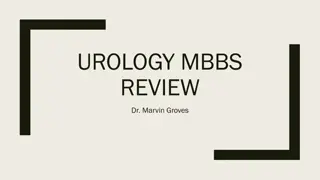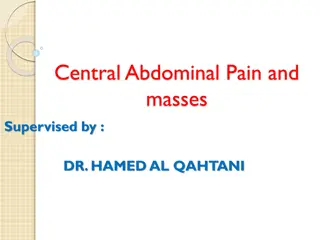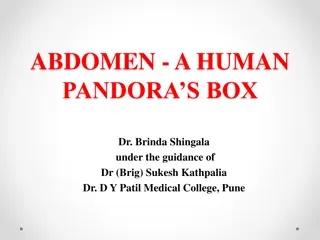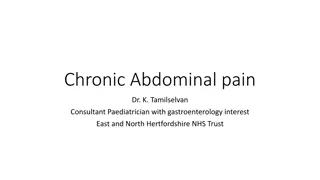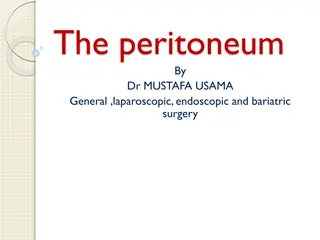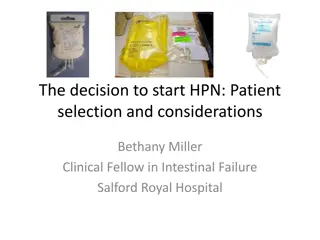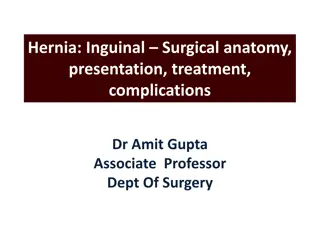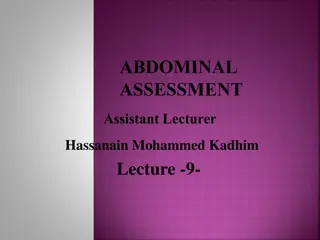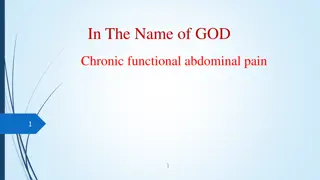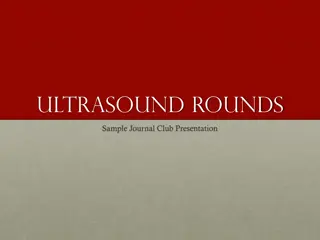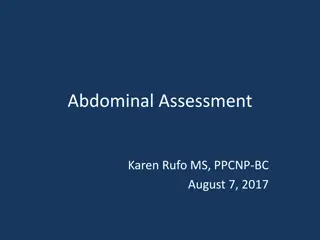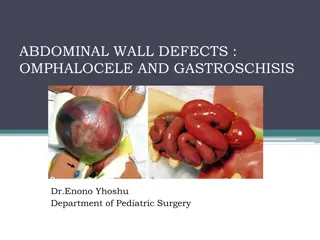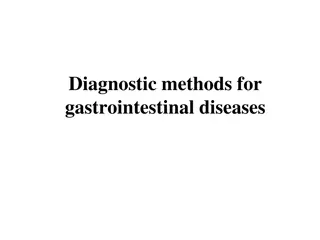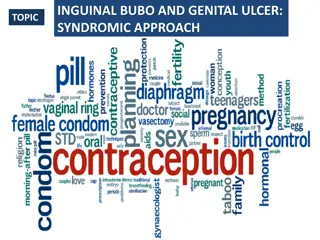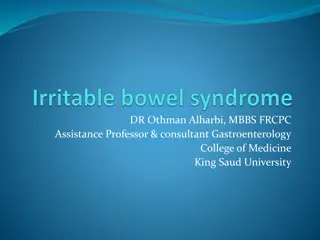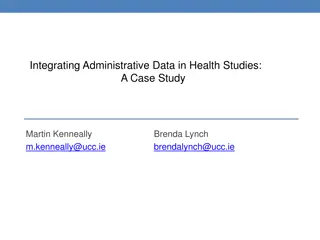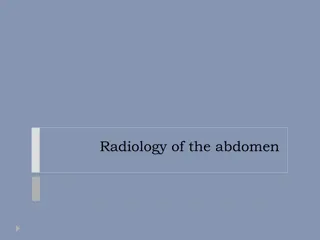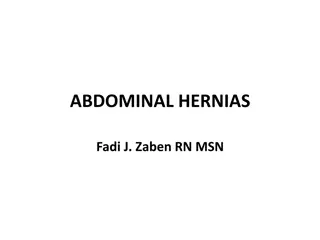Insect Abdominal Structures and Appendages: An Overview
The abdomen of insects plays crucial roles in respiration, reproduction, digestion, excretion, and metabolism. The number of abdominal segments varies across species, with reductions and modifications seen in different insect groups. From the propodeum to pregential and postgenital segments, each pa
3 views • 6 slides
abdominal Sarcoma treatment specialist in Pune
Dr Manoj Dongare provides the best treatment for abdominal sarcomas. He is the best abdominal Sarcoma treatment specialist in Pune
0 views • 1 slides
Case Review: Diagnostic Dilemma in Urology - Management Approach for a Patient with Abdominal Pain and Fever
A 58-year-old man with a history of diabetes and hypertension presents with fever and abdominal pain, raising multiple differential diagnoses including symptomatic AAA, pyelonephritis, acute appendicitis, complicated urolithiasis, or diabetic ketoacidosis. The case explores clinical manifestations,
1 views • 35 slides
Central Abdominal Pain and Masses in Clinical Practice
Abdominal pain evaluation involves considering various differential diagnoses such as appendicitis, small bowel obstruction, and mesenteric ischemia. By categorizing pain as visceral, parietal, referred, or radiating, healthcare providers can better understand the underlying pathology. The history o
0 views • 57 slides
Abdominal Health: Diagnostic Journey of a Complex Case
In this detailed case study, a 37-year-old woman presents with abdominal distension and pain, leading to a diagnosis of a mucinous cystadenoma. Through advanced imaging techniques and surgical exploration, the medical team navigates the complexities of her condition, highlighting the challenges and
0 views • 11 slides
Chronic Abdominal Pain in Children: Causes, Diagnosis, and Treatment
Chronic abdominal pain in children is a common issue, with underlying organic diseases being relatively uncommon. Factors such as stress, parental anxiety, and genetic predisposition can contribute to these symptoms. It is crucial to differentiate between functional and organic GI disorders through
1 views • 28 slides
Comparative Study of Abdominal Bones in Various Animals
Study of the abdominal bones in the ox highlights characteristics like elongated transverse and curved articular processes, whereas differences in horse bones include shorter bodies and varying curvature of transverse processes. Understanding these anatomical variances provides insights into the uni
0 views • 16 slides
The Peritoneum: Structure, Functions, and Inflammatory Responses
The peritoneum, a vital membrane in the body's abdominal cavity, consists of visceral and parietal components with distinct pain perceptions. It plays crucial roles in lubrication, fluid absorption, immune responses, and more. Peritoneal inflammatory exudate can result from various causes such as ba
0 views • 36 slides
Case Study of a 33-Year-Old Woman with Complex Health Issues
This case study examines the health issues of a 33-year-old woman, including physical symptoms such as abdominal pain, urinary urgency, constipation, and migraines, as well as mental health struggles related to her past marriage. Despite various medical examinations, her condition remains unresolved
1 views • 31 slides
Proper Abdominal Incision Techniques in Surgery
Proper abdominal incision techniques are crucial in surgical procedures to ensure successful outcomes. Factors such as skin tension lines, anatomical structures, cosmetic considerations, and procedural access must be carefully considered when planning and executing incisions. The use of appropriate
0 views • 29 slides
WHO's HiAP Framework and Global Mandates for Health Equity
This content discusses the HiAP Framework for Country Action and Global Mandates for promoting health equity. It covers resolutions, declarations, and recommendations by various organizations to address social determinants of health and reduce health inequities. The WHO Director-General is urged to
1 views • 11 slides
Abdominal Trauma: Epidemiology, Mechanism, Evaluation & Management
Abdominal trauma is a significant concern, notably in road traffic accidents. Blunt abdominal trauma (BAT) accounts for a majority of cases, with injuries commonly affecting the spleen and liver. Various mechanisms of injury and evaluation techniques, including examination signs and lab tests, aid i
0 views • 12 slides
Parenteral Nutrition in Intestinal Failure Related to Advanced Abdominal Cancer
Discussion on parenteral nutrition in patients with intestinal failure secondary to advanced abdominal cancer, including considerations for patient selection, Christie referral pathway, and practicalities of home parenteral nutrition. The background highlights the increasing commonality of home pare
0 views • 40 slides
Comprehensive Overview of Inguinal Hernia: Anatomy, Presentation, and Treatment
Inguinal hernia is characterized by an abnormal protrusion of viscus or a part of it through a weak point in the abdominal wall. It involves the anatomy of the inguinal region, including the superficial and deep inguinal rings, inguinal canal boundaries, and defense mechanisms. The anatomical classi
0 views • 37 slides
Equity in Development Partners Support on Health Financing in Lao PDR P4H Meeting
The meeting focuses on addressing health indicators, inequities, and health financing challenges in Lao PDR. It analyzes the background of health indicators, inequities by socio-economic status and ethnic groups, and the current health financing situation in the country. The discussion delves into s
1 views • 23 slides
Comprehensive Guide to Abdominal Assessment for Healthcare Professionals
This lecture by Hassanain Mohammed Kadhim covers the essential techniques and subjective data needed for a thorough abdominal assessment. It includes objectives, equipment required, preparation steps, subjective data collection, inspection guidelines, abdominal landmarks, common causes of abdominal
0 views • 21 slides
Chronic Functional Abdominal Pain: Clinical Diagnosis and Management
Chronic functional abdominal pain is characterized by persistent discomfort lasting over three months, with various underlying causes such as gastrointestinal disorders, genitourinary issues, and miscellaneous conditions. Diagnosis involves differential assessment and recognizing functional disorder
0 views • 26 slides
Ultrasound Rounds: Clinical Case Study of 31-Year-Old Female with Abdominal Pain
31-year-old female presents to the emergency department with sudden onset severe abdominal pain localized to the RLQ. Her clinical history and examination findings are detailed, along with lab results showing positive beta-hCG. Ultrasound examination techniques including transabdominal and transvagi
0 views • 32 slides
Comprehensive Guide to Abdominal Assessment Methods
Learn the critical order of examination for abdominal assessment, including inspection, auscultation, percussion, and palpation. Understand how to assess skin characteristics, symmetry, abdominal muscles, bowel sounds, vascular sounds, organ size, and tenderness. Discover techniques to identify abno
0 views • 72 slides
Abdominal Wall Defects: Omphalocele and Gastroschisis Overview
Abdominal wall defects such as omphalocele and gastroschisis are congenital conditions where abdominal organs protrude through an unusual opening in the abdomen. These defects result from disruptions during embryonic development, leading to serious implications for affected individuals. Different ty
1 views • 42 slides
Comprehensive Radiological Imaging Review in Abdominal and Adrenal Pathologies
This extensive radiological imaging review covers a wide range of topics in abdominal and adrenal pathologies, discussing differential diagnoses, imaging modalities such as CT and USG, specific syndromes like prune belly syndrome, and conditions like retroperitoneal fibrosis. It delves into various
0 views • 39 slides
Abdominal Pain, Jaundice & Abnormal Liver Function Tests in an 8-Year-Old Boy
An 8-year-old boy presents with intermittent abdominal pain that occurs before breakfast and sometimes at school, relieved by activities. He also exhibits jaundice and abnormal liver function tests, indicating a potential underlying liver issue. Immediate medical evaluation is necessary to diagnose
0 views • 33 slides
Appendicitis: Causes, Symptoms, and Diagnosis
Appendicitis is a common cause of acute abdominal pain requiring surgical intervention. It predominantly affects individuals between 10 to 20 years, with abdominal pain being a key symptom. Diagnosis often involves imaging tests such as CT scans or ultrasound, along with physical examinations like R
0 views • 17 slides
Necrotizing Enterocolitis: Causes, Symptoms, Diagnosis, and Treatment
Necrotizing Enterocolitis (NEC) is a serious condition affecting mainly premature infants, with unknown exact causes but potential risk factors like impaired mucosal barrier and feeding issues. Clinical manifestations include feeding intolerance, abdominal distention, and blood in stools. Diagnosis
0 views • 23 slides
Diagnostic Methods for Gastrointestinal Diseases: A Comprehensive Overview
Explore various diagnostic methods for gastrointestinal diseases, including laboratory investigations, abdominal ultrasound features, and radiology techniques. Learn about the significance of different tests such as ESR, blood count, liver tests, and abdominal ultrasound in diagnosing conditions aff
0 views • 40 slides
Inguinal Bubo and Genital Ulcer: Syndromic Approach by Dr. Rohit Kumar Singh
This informative content discusses the syndromic approach to managing inguinal bubo, genital ulcers, urethral discharge, scrotal swelling, vaginal discharge, lower abdominal pain, and neonatal conjunctivitis. It includes recommended treatment regimens for lower abdominal pain and emphasizes the impo
0 views • 140 slides
Irritable Bowel Syndrome and Its Pathophysiology
Irritable bowel syndrome (IBS) is a common gastrointestinal disorder characterized by chronic abdominal pain and altered bowel habits. Despite the absence of organic causes, patients experience symptoms such as abdominal distention, bloating, and visceral hypersensitivity. The pathophysiology of IBS
0 views • 19 slides
Integrating Administrative Data in Health Studies: A Case Study
This case study explores the integration of administrative data in health studies focusing on profiling the health status of Irish regions in 2010. The objectives include linking regional health profiles to prescribing patterns, incorporating demographics and drug scheme coverage rates, and simulati
1 views • 17 slides
EU4Health Programme: Transforming Public Health in Europe
The EU's financial strategy and priorities in the health domain are highlighted through the EU4Health programme, aiming to enhance public health in Europe. The HaDEA is actively involved in improving health in the Union, protecting against cross-border health threats, ensuring availability of afford
1 views • 11 slides
Radiology of the abdomen
Abdominal radiology plays a crucial role in diagnosis using modalities such as X-ray, fluoroscopy, ultrasound, CT scan, and MRI. This technology helps assess conditions like bowel obstructions, calcifications, and more. Interpreting the gas patterns, diameters, and signs seen in abdominal imaging is
0 views • 47 slides
22-Year-Old Woman with Abdominal Pain Case Study
This case study explores a 22-year-old woman presenting with abdominal pain, discussing the chief complaint, history of present illness, and possible diagnoses based on illness scripts. It includes an outline of illness scripts for the top three diagnoses, covering pathophysiology, epidemiology, sym
0 views • 28 slides
Abdominal Pain in Children
the causes, history taking, physical examination, normal findings, and management approach for abdominal pain in children presented by Consultant Paediatrician Dr. Helen Goodyear. Learn about common conditions like gastroenteritis, appendicitis, and UTI, along with the importance of thorough evaluat
0 views • 22 slides
PACES Abdomen
Explore a comprehensive approach to diagnosing abdominal findings in cases related to hepatology, chronic liver disease, portal hypertension, renal diseases, and hematological malignancies. Learn to identify key abdominal signs and interpret various types of scars to aid in medical assessments.
0 views • 19 slides
Intra-Abdominal Candidiasis,
Intra-abdominal candidiasis is an important clinical entity with diverse manifestations and risk factors. Learn about its classification, common forms, microbiology, clinical features, and management strategies. Explore the spectrum of disease and understand the different types of peritonitis associ
1 views • 15 slides
35-Year-Old Male with Abdominal Pain, Cramping, and Urinary Symptoms
A 35-year-old male presents to the ED with complaints of abdominal pain and cramping, along with pus and blood in his urine. He mentions a recent history of food poisoning-like symptoms, vomiting, and dysuria. Past medical history includes meth/ETOH abuse, rectal abscess, and recent vaccinations. Ph
0 views • 8 slides
Integrative Care of a Child with Abdominal Pain
This case presentation explores the integrative care of a 7-year-old child experiencing functional abdominal pain. Analyzing the case, describing pathophysiology theories, and evaluating treatment options based on research are key aspects covered.
0 views • 20 slides
NEXT WEEK: ABDOMINAL EXAM (JAN 14, 2020)
clinical experiences and educational opportunities focusing on abdominal examination abnormal findings. Gain valuable insights from real patient cases and practical workshops. Enhance your diagnostic skills and understanding of various medical conditions through personalized feedback and case discus
0 views • 7 slides
ABDOMINAL HERNIAS
Abdominal hernias occur when organs or tissues protrude through the abdominal wall, often caused by congenital or acquired weaknesses. Learn about the etiology, classification by site, and severity of abdominal hernias such as inguinal, femoral, umbilical, ventral, and peristomal hernias.
0 views • 27 slides
University of Basrah College of Nursing Health Promotion Course
Dive into the crucial components of health assessment focusing on examination and inspection techniques in nursing practice. Explore the systematic process of assessing general and specific health indicators, including vital signs and abdominal examination.
0 views • 32 slides
Case Presentation: Fever and Abdominal Pain in an 8-Year-Old Female
An 8-year-old female, Meherunisha Molla, presents with a 7-day history of low-grade fever, yellowish discoloration of eyes and urine, and abdominal pain. Past history includes a previous fever episode, and no significant family history. Initial examination reveals a palpable liver with normal spleni
0 views • 24 slides


